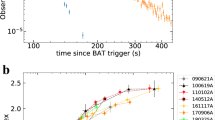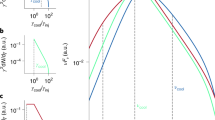Abstract
The spectra of γ-ray bursts, which are generally thought to result from a transient phenomenon on a neutron star, extend from the optical up to γ-ray energies. It has recently been suggested1 that the whole spectrum may be due to irradiation of a reprocessing and reflecting boundary near a source of power-law γ-rays with a low-energy cutoff E0 ≈ 300–500 keV. In this picture, the emission at intermediate energy (10 keV≲E≲300–500 keV) results from the reflection of incipient high-energy γ-rays by the surface layers of the underlying neutron star and/or its accretion disk. Some bursts display high-energy (∼400-keV) features, which may be gravitationally redshifted photons produced from the annihilation of electron–positron pairs. This explanation, however, has been open to criticism. I show that an alternative explanation for the high-energy features may be the superposition of the incipient and reflected spectral components near E0.
This is a preview of subscription content, access via your institution
Access options
Subscribe to this journal
Receive 51 print issues and online access
$199.00 per year
only $3.90 per issue
Buy this article
- Purchase on Springer Link
- Instant access to full article PDF
Prices may be subject to local taxes which are calculated during checkout
Similar content being viewed by others
References
Melia, F. Astrophys. J. (in the press).
Mazets, E. P. et al. Pisma Astr. Zh. 6, 706–111 (1980).
Liang, E. P. & Petrosian, V. Am. Inst. Phys. Conf. Proc. (American Institute of Physics, New York, 1986).
Fenimore, E. E., Klebesadel, R. W., Laros, J. G. & Stockdale, R. E. Nature 297, 665–667 (1982).
Kluźniak, W. Astrophys. J. (submitted).
Norris, J. P. thesis. Univ. of Maryland (1983).
Kouveliotou, C. Astrophys. J. 330, L101–L105 (1988).
Barat, C. et al. Astrophys. J. 286, L5–L9 (1984).
Murakami, T. et al. Nature 335, 234–235 (1988).
London, R. A. & Cominsky, L. R. Astrophys. J. 275, L59–L63 (1983).
Melia, F. et al. Astrophys. J. 305, L51–L55 (1986).
Hartmann, D. H. et al. Bull. Am. astr. Soc. 18, 928 (1986).
Melia, F. Fundam. cosmic. Phys. 12, 241–254 (1987).
Melia, F. Proc. Sofia COSPAR Symp. (ed. White, N.) (in the press).
Melia, F. Astrophys. J. 324, L21–L25 (1988).
Melia, F. Astrophys. J. (in the press).
Cline, T. L. in High Energy Transients in Astrophysics (ed. Woosley, S. E.) 333–342 (Am. Inst. Phys., New York, 1984).
Hueter, G. J. in High Energy Transients in Astrophysics (ed. Woosley, S. E.) 373–377 (Am. Inst. Phys., New York, 1984).
Matz, S. M. et al. Astrophys. J. 288, L37–L40 (1985).
Melia, F. & Königl, A. Astrophys. J. (in the press).
Kafka, P. & Meyer, F. in High Energy Transients in Astrophysics (ed. Woosley, S. E.) 578–580 (Am. Inst. Phys., New York, 1984).
Matz, S. M. thesis, Univ. of New Hampshire (1986).
Author information
Authors and Affiliations
Rights and permissions
About this article
Cite this article
Melia, F. A new interpretation of emission-like features in γ-ray burst spectra. Nature 336, 658–660 (1988). https://doi.org/10.1038/336658a0
Received:
Accepted:
Issue Date:
DOI: https://doi.org/10.1038/336658a0
This article is cited by
Comments
By submitting a comment you agree to abide by our Terms and Community Guidelines. If you find something abusive or that does not comply with our terms or guidelines please flag it as inappropriate.



